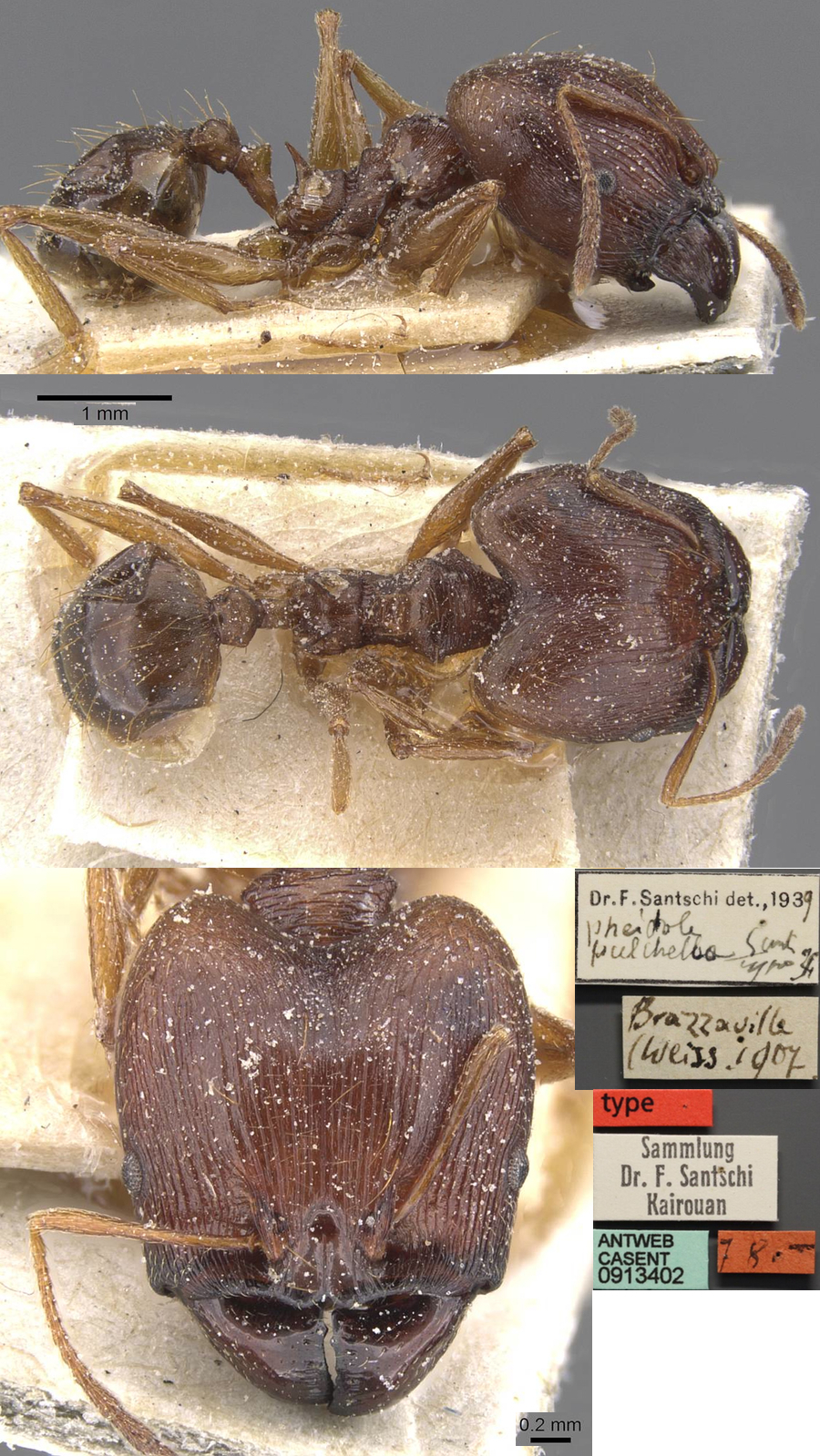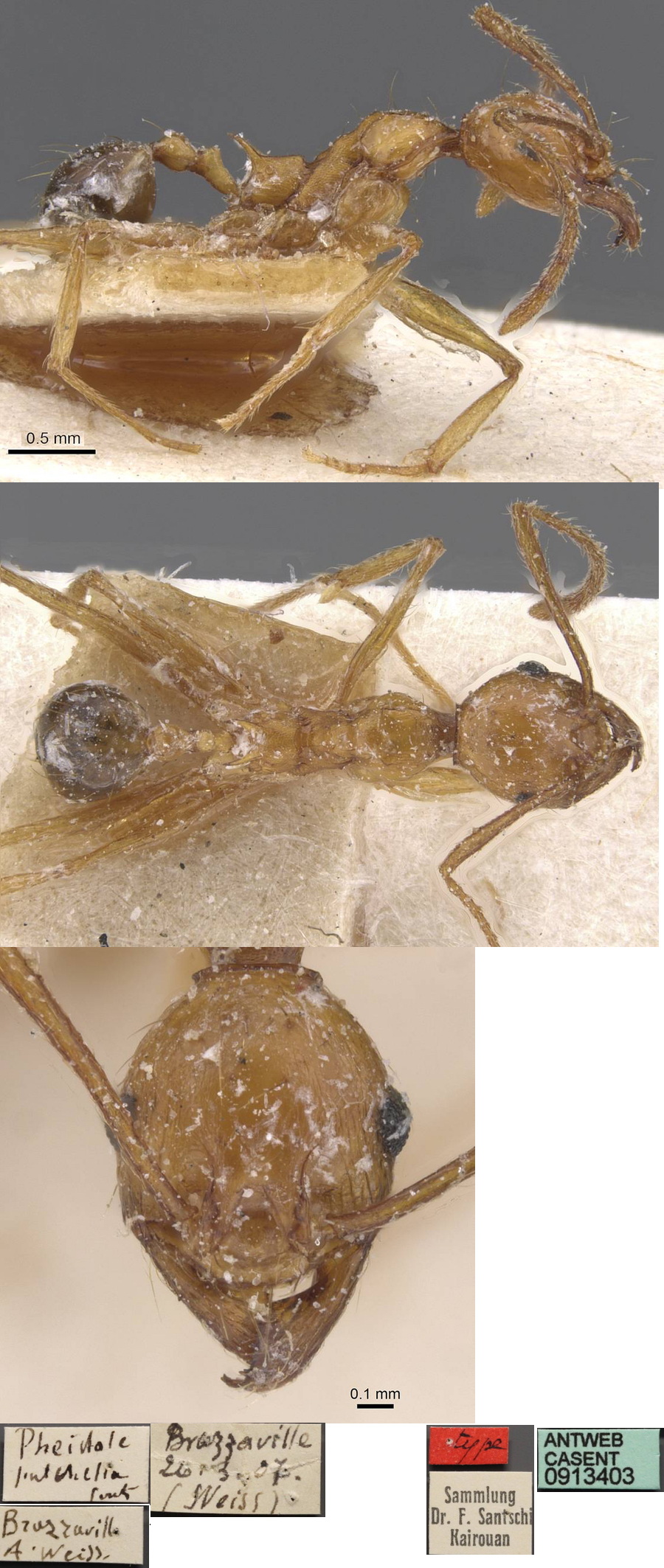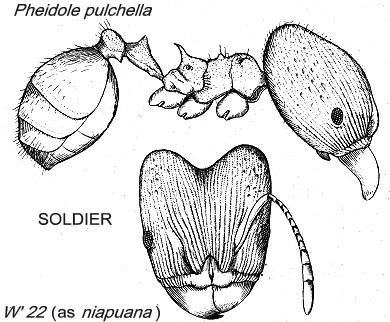Pheidole pulchella Santschi
  Type location Congo
(Santschi, 1910c: 360, minor; Santschi,
1939b: 242, major) Brazzaville, by A. Weiss - see below Type location Congo
(Santschi, 1910c: 360, minor; Santschi,
1939b: 242, major) Brazzaville, by A. Weiss - see below
junior synonym niapuana (Pheidole
niapuana, new
species, Wheeler, 1922: 136, illustrated, major & minor; synonymy
by Santschi, 1930a: 59) - see below
subspecies nominal plus achantella (Ph. pulchella Sant. v. achantella n. v., Santschi,
1939b: 242, major) from Congo - see http://www.antweb.org/specimenImages.do?code=casent0913404
major & minor only described
(see Bolton, 1995)  . .
|
Santschi's (1910c) description is at  . Santschi's (1939b) description, with achantella
is at . Santschi's (1939b) description, with achantella
is at  . Reviewed by Fischer et al (2012: 33),
with synonymy confirmed and new findings from Gabon. . Reviewed by Fischer et al (2012: 33),
with synonymy confirmed and new findings from Gabon.
|
 The
photomontage of the type major worker is collated from http://www.antweb.org/specimen.do?name=casent0913402. The
photomontage of the type major worker is collated from http://www.antweb.org/specimen.do?name=casent0913402.
|
 The
photomontage of the type minorr worker is collated from http://www.antweb.org/specimen.do?name=casent0913403. The
photomontage of the type minorr worker is collated from http://www.antweb.org/specimen.do?name=casent0913403.
|
 Description,
as Pheidole niapuana by Wheeler (1922) Description,
as Pheidole niapuana by Wheeler (1922)
MAJOR - Length 5 to 5.5 mm. Head, excluding the
mandibles, as broad as long (2.3 mm.), cordate, considerably broader
behind than in front, and with the occipital border very deeply and
arcuately excised. Behind the eyes the sides are convex but in front
feebly concave. Eyes small, moderately convex, situated just in front
of the anterior third of the head. In profile the head is most convex
in the middle both above and below, but depressed in the occipital
region. Frontal and occipital groove distinct but rather shallow
anteriorly. Mandibles large and convex, with two blunt teeth at the
apex. Clypeus flat, carinate, its anterior border emarginate in the
middle, bluntly bidentate, sinuate on the sides. Frontal area large,
subtriangular, without a median carinula; frontal carinae short,
diverging, continued back as delicate rugae bordering an indistinct
scrobe-like depression for the antennal scapes. Antennae slender,
scapes terete, curved at the base, reaching to the middle of the sides
of the head; all the funicular joints longer than broad, club somewhat
shorter than the remainder of the funiculus. Gula with a pair of very
large, blunt teeth at the anterior margin. Thorax short and robust,
shorter than the head without the mandibles. Pronotum with very
distinct and moderately acute humeral tubercles, mesonotum sloping to a
deep metanotal constriction, with a sharp transverse welt or ridge;
propodeum broader than long, concave and sloping in the middle; spines
acute, somewhat shorter than the base, a little longer than their
interval, directed upward and slightly outward and backward, with their
tips distinctly curved backward. Petiole very small, narrow, fully
twice as long as broad, with subparallel sides, the node short, with
acute transverse superior border, distinctly notched in the middle.
Postpetiole three times as broad as the petiole, subtriangular, broader
than long and broader behind than in front, with prominent, bluntly
angular sides, its ventral surface with a distinct tooth, its dorsal
surface convex and rounded. Gaster broadly elliptical, smaller than the
head. Legs rather slender, femora only moderately thickened in the
middle.
Shining; mandibles sparsely punctate, striated at their bases. Head
longitudinally rugose, the rugae sharp, widely separated and not very
strong, the interrugal spaces with dense shallow punctures, most
distinct on the space between two rugae representing a very feeble
scrobe-like area. The rugae on the front diverge, passing to the
summits of the occipital lobes. Sides of head with finer, denser rugae.
Occipital lobes with large, scattered foveolae. Thorax, petiole and
postpetiole covered with fine shallow punctures, more pronounced on the
mesopleurae and extremely fine and dense on the petiole and postpetiole
which are opaque. Pronotum transversely rugulose. Basal half of first
gastric segment finely reticulate-punctate and less shining than the
remainder of the gaster.
Colouration - hairs reddish yellow, glistening, coarse, uneven, erect,
and rather sparse on the body; short, sparse, and appressed on the
scapes and legs. Overall rich ferruginous red; clypeus and borders of
mandibles black; legs and antennae paler and more yellowish red; gaster
infuscated on the sides and behind the first segment.
|
|
MINOR - Length 3 to 3.5 mm. Head nearly
circular, scarcely longer than broad, without posterior corners,
occipital border strongly marginate. Mandibles large, their apical
borders long and finely denticulate, with two larger terminal teeth.
Clypeus convex, with rounded, entire anterior border. Eyes just in
front of the middle of the head, moderately large and convex. Antennae
slender, scapes extending about two-fifths their length beyond the
occipital border. Thorax slender, the pronotum rather depressed above,
bluntly tuberculate on the sides near the middle. Mesonotum long and
sloping, with a broad transverse impression in front and a transverse
swelling behind it. Metanotal constriction deep and broad. Propodeum as
broad as long, with subequal base and declivity, not concave in the
middle as in the major. Spines longer, as long as the base and more
strongly curved backward. Petiole similar to that of the soldier, but
with a lower, blunter node. Postpetiole scarcely twice as broad as the
petiole, longer than broad, rounded above and on the sides. Gaster
distinctly smaller than the head. Legs slender.
Overall shining; finely reticulate; mandibles finely and densely
striate, lustrous; gaster more shining than the head and thorax;
mesonotum and propodeum and ventral and lateral portions of the petiole
and postpetiole subopaque, densely punctate. Pilosity much like that of
the major, sparser on the body but more abundant on the legs. Colour
much paler, of a more yellowish red, or reddish yellow, with paler legs
and brown gaster, the latter in most specimens yellowish at the base.
Described from numerous specimens of both phases taken
by Lang and Chapin at Niapu, Zaïre, "from nests in the rotten
wood of fallen trees or in old roots." This species is evidently
related to P. areniphila Forel of the Kalahari Desert but is
certainly distinct, being larger and differing in many details of
structure and sculpture.
|
 The photomontage of cotypes of niapuana is
collated from The Smithsonian Institute images at http://ripley.si.edu/ent/nmnhtypedb/public/specimeninfopage.cfm?publicconsumption=1&typespecimenID=880. The photomontage of cotypes of niapuana is
collated from The Smithsonian Institute images at http://ripley.si.edu/ent/nmnhtypedb/public/specimeninfopage.cfm?publicconsumption=1&typespecimenID=880.
|
 The photomontage of a cotype minor of the type form is
collated from The Smithsonian Institute images at http://ripley.si.edu/ent/nmnhtypedb/public/specimeninfopage.cfm?publicconsumption=1&typespecimenID=967. The photomontage of a cotype minor of the type form is
collated from The Smithsonian Institute images at http://ripley.si.edu/ent/nmnhtypedb/public/specimeninfopage.cfm?publicconsumption=1&typespecimenID=967.
|
|